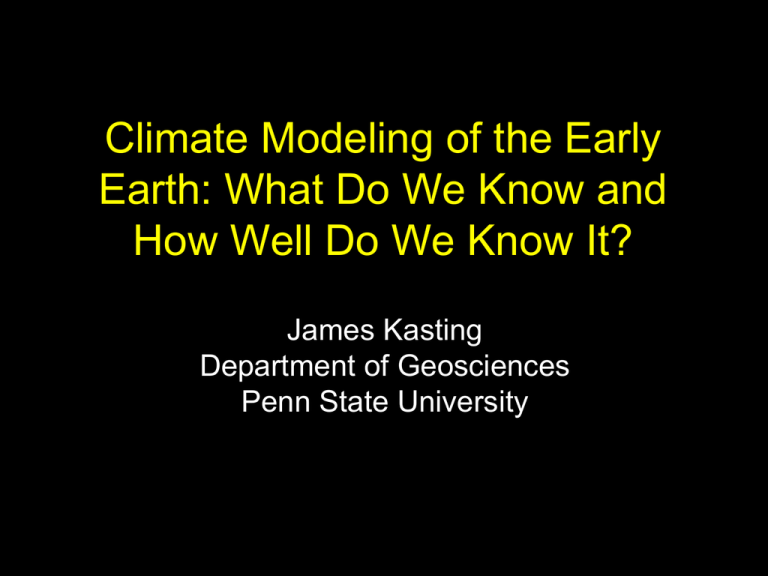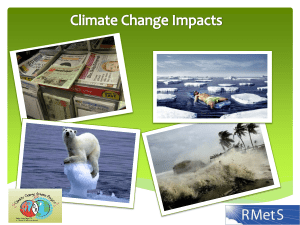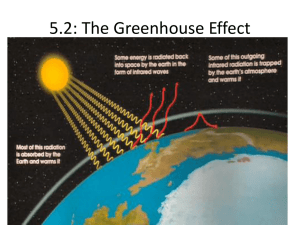warm - STScI
advertisement

Climate Modeling of the Early Earth: What Do We Know and How Well Do We Know It? James Kasting Department of Geosciences Penn State University Ice age (Late Cenozoic) Dinosaurs go extinct Warm First dinosaurs Phanerozoic Time Ice age Age of fish First vascular plants on land Ice age First shelly fossils Geologic time First shelly fossils (Cambrian explosion) Snowball Earth ice ages Warm Rise of atmospheric O2 (Ice age) Ice age Warm (?) Origin of life Evidence for 2.9-Ga glaciation • One finds diamictites and dropstones in the 2.9-Ga Mozaan Group in South Africa, within the Pongola Basin • Diamictites are called tillites once their glacial origin is established • Diamictites are also found in the Belingue Greenstone Belt in Zimbabwe (E. M. Nisbet et al. Geology, 1993), although they were not identified as glacial by the authors G.M. Young et al., J. Geol. (1998) 2.9-Ga dropstone • Dropstones are fistsized (or larger) chunks of rocks found in laminated marine sediments that are thought to have been deposited by melting icebergs • This one was found in the muddy upper layers of the diamictites shown in the previous slide G.M. Young et al., J. Geol. (1998) • The geologic data suggest that the Archean was cool (but not frozen), at least some of the time • By contrast, oxygen isotope data from cherts (SiO2), appear to indicate that the Achean Earth was hot, 7015oC, at 3.3 Ga • Indeed, data from carbonates (not shown) suggest that the Earth remained warm up until ~400 Ma • These isotopic data have multiple interpretations, some of which will come up during Paul Knauth’s talk (SMOW) Oxygen isotope evidence for a hot early Earth? Cold Warm P. Knauth, Paleo3 219, 53 (2005) Surface temperature vs. pCO2 and fCH4 3.3 Ga S/So = 0.77 • Getting surface temperatures of ~70oC at 3.3 Ga would require of the order of 3 bars of CO2 (10,000 times present), possibly more, as the greenhouse effect of CH4 was overestimated in these calculations • pH of rainwater would drop from 5.7 to ~3.7 • Would this be consistent with evidence of paleoweathering? Kasting and Howard, Phil. Trans. Roy. Soc. B (2006) • From a theoretical standpoint, it is curious that the early Earth was warm, because the Sun is thought to have been less bright Why the Sun gets brighter with time • H fuses to form He in the core • Core becomes denser • Core contracts and heats up • Fusion reactions proceed faster • More energy is produced more energy needs to be emitted Figure redrawn from D.O. Gough, Solar Phys. (1981) • Various astronomers have come up with proposals for altering the standard solar evolution model, and we will hear about that at this meeting • For now, I will assume that the young Sun was indeed faint • This has big implications for planetary climates, as first pointed out by Sagan and Mullen (1972)… The faint young Sun problem Te = effective radiating temperature = [S(1-A)/4]1/4 TS = average surface temperature Kasting et al., Scientific American (1988) • Feedbacks are important in the climate system • One way to describe these is with systems diagrams Systems Notation = system component = positive coupling = negative coupling Positive Feedback Loops (Destabilizing) Water vapor feedback Surface temperature Atmospheric H2O (+) Greenhouse effect The faint young Sun problem More H2O Less H2O • The best solution to this problem is higher concentrations of greenhouse gases in the distant past (but not H2O, which only makes the problem worse) Greenhouse gases • Greenhouse gases are gases that let most of the incoming visible solar radiation in, but absorb and reradiate much of the outgoing infrared radiation • Important greenhouse gases on Earth are CO2, H2O, and CH4 – H2O, though, is always near its condensation temperature; hence, it acts as a feedback on climate rather than as a forcing mechanism • The decrease in solar luminosity in the distant past could have been offset either by higher CO2, higher CH4, or both. Let’s consider CO2 first The carbonate-silicate cycle (metamorphism) • Silicate weathering slows down as the Earth cools atmospheric CO2 should build up • This is probably at least part of the solution to the faint young Sun problem Negative feedback loops (stabilizing) The carbonate-silicate cycle feedback Rainfall Surface temperature (−) Greenhouse effect Silicate weathering rate Atmospheric CO2 CO2 vs. time if no other greenhouse gases (besides H2O) J. F. Kasting, Science (1993) • In the simplest story, atmospheric CO2 levels should have declined monotonically with time as solar luminosity increased • Geochemists, however, insist on making the story more complicated… Sheldon’s pCO2 estimate from paleosols • First published estimate of Archean CO2 from paleosols came from Rye et al. (1995) (probably incorrect) • Sheldon presented an alternative analysis of paleosols based on mass balance arguments (efficiency of weathering) • Sheldon’s calculated pCO2 at 2.2 Ga is also about 0.008 bar, or 28 PAL, with a quoted uncertainty of a factor of 3 • New estimate for pCO2 at 2.7 Ga (Driese et al., 2011): 10-50 PAL Driese et al., 2011 N. Sheldon, Precambrian Res. (2006) Rosing et al.: CO2 from BIFs von Paris et al. Ohmoto Rye et al. Sheldon (old) (pCO2 3 PAL) J. F. Kasting Nature (2010) • More recently, Rosing et al. (Nature, 2010) have tried to place even more stringent constraints on past CO2 using banded iron-formations (BIFs) • I have argued with these estimates, but I’ll let the authors present them first, and then we can argue.. Sagan and Mullen, Science (1972) • Sagan and Mullen liked ammonia (NH3) and methane (CH4) as Archean greenhouse gases • As a result of Preston Cloud’s work in the late 1960’s, they were aware that atmospheric O2 was low on the early Earth • But Sagan and Mullen hadn’t thought about the photochemistry of ammonia Problems with Sagan and Mullen’s hypothesis • Ammonia is photochemically unstable with respect to conversion to N2 and H2 (Kuhn and Atreya, 1979) • There may be ways to salvage this hypothesis, or part of it, by shielding ammonia with fractal organic haze (see talk by Feng Tian) CH4 as an Archean greenhouse gas • CH4 is a better candidate for providing additional greenhouse warming • Substrates for methanogenesis should have been widely available, e.g.: CO2 + 4 H2 CH4 + 2 H2O • Methanogens (organisms that produce methane) are evolutionarily ancient – We can tell this by looking at their DNA Feedbacks in the methane cycle • Furthermore, there are strong feedbacks in the methane cycle that would have helped methane become abundant • Doubling times for thermophilic methanogens are shorter than for mesophiles • Thermophiles will therefore tend to outcompete mesophiles, producing more CH4 and further warming the climate CH4-climate positive feedback loop Surface temperature (+) CH4 production rate Greenhouse effect • Methanogens grow faster at high temperatures But, • If CH4 becomes more abundant than about 1/10th of the CO2 concentration, it begins to polymerize Titan’s organic haze layer • The haze is formed from UV photolysis of CH4 • It creates an antigreenhouse effect by absorbing sunlight up in the stratosphere and reradiating the energy back to space • This cools Titan’s surface Image from Voyager 2 Possible Archean climate control loop CH4 production (–) Surface temperature Haze production (–) CO2 loss (weathering) Atmospheric CH4/CO2 ratio CH4/CO2/C2H6 greenhouse with haze (Old—Rye et al.) Late Archean Earth? Driese et al. (2011) (10-50 PAL, 2.7 Ga) Water freezes • The Archean climate system would arguably have stabilized in the regime where a thin organic haze was present • We don’t quite make it to 288 K, using pCO2 from Driese et al. (2011) • Possible additional warming from higher pN2 or from albedo feedbacks? J. Haqq-Misra et al., Astrobiology (2008) • In any case, the climate crashed when pO2 rose at 2.4 Ga, wiping out much of the methane greenhouse and triggering glaciations Huronian Supergroup (2.2-2.45 Ga) High O2 Redbeds Glaciations Low O2 S. Roscoe, 1969 Detrital uraninite and pyrite Conclusions • The Sun really was ~30% dimmer during its early history, at least after the first 200 m.y. • CO2, CH4, and C2H6 may all have contributed to the greenhouse effect back when atmospheric O2 levels were low – Higher pN2 and lower planetary albedo could also have helped warm the climate, but these mechanisms (in my view) are more speculative • High atmospheric CH4/CO2 ratios can trigger the formation of organic haze. This has a cooling effect. – Stability arguments suggest that the Archean climate may have stabilized when a thin organic haze was present • The Paleoproterozoic glaciation at ~2.4 Ga may have been triggered by the rise of O2 and loss of the methane component of the atmospheric greenhouse









